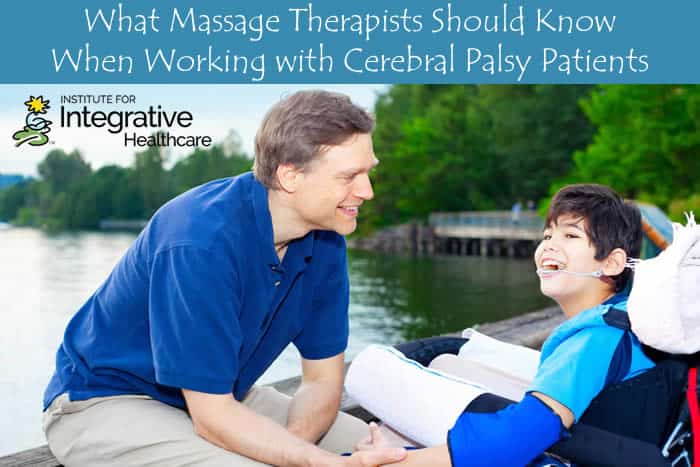What Massage Therapists Should Know When Working with Cerebral Palsy Patients

Take an in-depth look at all there is to know about Cerebral Palsy (CP) – especially as it pertains to working with this population in your massage practice. PLUS: Jimmy Gialelis shares candid details from a personal interview, which provides massage therapists with a healthy perspective to recall when working with CP patients.

What Is Cerebral Palsy?
Cerebral Palsy (CP) is an encompassing term representing a group of conditions characterized by various motor disorders: movement and postural dysfunction and/or muscle coordination challenges. These challenges stem from damage to the developing brain, most often before birth. Typically, the deficiencies of movement and muscle dysfunction do not worsen over time.
Each individual with CP presents with different degrees of clinical manifestations. Some patients present normal or near-normal intellectual ability whereas others present with intellectual / cognizant disabilities. (1)
2 Degrees and 4 Types of CP
Two key terms in describing Cerebral Palsy patients are hypotonia and hypertonia. These correlate with the degree of muscle tonicity present.
- Hypotonia: Lack of muscle tonicity, decreased strength present.
- Hypertonia: Excessive muscle tonicity, muscle rigidity and spasms present.
1. The most common type of Cerebral Palsy is termed Spastic. Comprising of 70-80% of cases, these patients present with signs of hypertonia, including abnormal gait, reflex dysfunction, contractures and spastic and rigid musculature. This type is also called Pyramidal, as damage is witnessed within the pyramid tracts of the brain’s cerebellum, the portion of the brain controlling muscle movement.
2. Ten percent of CP cases are Athetoid, characterized by fluctuations in muscle tonicity and involuntary movement of the face, torso and limbs. Inability to maintain posture, feeding challenges and rigidity accompany the involuntary movements. This type is also called Extrapyramidal, because the source of damage lies beyond the normal pyramidal tracts, most notably present in the brain’s basal ganglia.
3. A rare form of CP is Ataxic, referring to the challenges witnessed with voluntary movements. Poor coordination, balance and abnormally wide gait presents with this form of CP. Tremors may be witnessed in skeletal muscle with difficulty speaking and labored arm movements may also present.
4. The final type of CP is called Mixed. A combination of the aforementioned types is witnessed with the most being Spastic and Athetoid. This results from the brain receiving damage in multiple locations. (2)
More Terms Related to Cerebral Palsy
Other nomenclature used to describe the impact of CP upon an individual includes: (3)
- Hemiplegic: Paralysis witnessed in an arm and leg on same side.
- Monoplegia: Paralysis witnessed in one limb or region.
- Diplegia: Paralysis witnessed in both lower limbs.
- Triplegia: Paralysis witnessed in three limbs/
- Quadriplegia: Paralysis witnessed in all four limbs affected.
Etiology (Cause)
Fetal brain damage to one or more areas of the brain is the likely cause. This damage may occur in a myriad of manners:
- Congenital: In utero or during the birthing process
- Acquired: During infancy or early childhood (4)
If acquired after childbirth, the most likely causes in infancy are:
- Infection, such as meningitis and encephalitis which adversely affect brain tissue.
- Trauma due to falls, motor vehicle accident and child abuse causing physical injury to the brain.
- Prolonged interruption of blood flow to the brain due to strokes, heart defect or sickle cell disease.
Epidemiology (Frequency)
Cerebralpalsy.org estimates approximately 764,000 Americans (children and adults) manifest one or more forms of CP, with 500,000 of these patients being under age 18.
- Approximately 10,000 babies born each year will develop a form of CP.
- Between 1,200-1,500 preschool children will be recognized and diagnosed with CP each year.
- Boys have a 40% greater chance of developing this condition than girls. (5)
9 Signs and Symptoms of Cerebral Palsy
Common physical manifestations may vary greatly and include the following:
- Muscle tightness or spasticity
- Gait/mobility disturbance (“scissor gait”)
- Involuntary movements (“choreal”)
- Difficulty swallowing/feeding/speaking
- Abnormal sensory perception
- Idiopathic seizures (unknown cause)
- Breathing problems
- Bowel and bladder challenges
- Skin lesions, such as sores
5 Treatments for Cerebral Palsy
Although incurable, there are several treatment options available. Because these conditions manifest uniquely with each child, early detection and intervention is key to the aid of the child. (6)
Treatment options include:
- Surgery to correct movement challenges
- Braces and other walking aid devices
- Complimentary therapies including Physical, Occupational, Speech and Massage
- Computer technology to aid communication
- Antidepressant, anti-seizure and muscle relaxant medications
Recommendations for Massage Therapists When Working with Cerebral Palsy Patients
Massage efforts designed to relieve muscle tension contributing to their signs and symptoms is the ideal approach. A mindful approach to the session encouraging the therapist to work slowly, intently with tissue will be best.
If hypertonia presents, massage techniques to reduce muscle tension are best. These may include neuromuscular therapy, deep tissue massage, cranial sacral therapy and myofascial release methods.
If hypotonia presents, massage techniques to stimulate muscle tissue are best. This includes quickening the pace of vibration and percussion strokes, including friction strokes to relieve adhesions, and the use of IASTM and cupping techniques.
My Candid Interview with a CP Patient
Heather Wreschnig, CP patient in Charlotte, North Carolina, candidly relays her experiences with receiving massage treatments. When inquired if she has received massage, Heather replies:
“I have and my experiences have varied among therapists. At best, I’ve found a great sense of relaxation during and for a short period of time after the session. Because my pectoral muscles are very tight, they tend to pull my shoulders forward, causing pain and knots in my upper back. Multiple sessions have helped alleviate some of these knots, temporarily loosening my pectoral muscles. Because my body is constantly resisting, it does not last if not kept up. This will vary among CP patients, depending on how severe their symptoms are. I have had massage therapists who constantly comment on how tight my muscles are during the session. I understand commenting on it, but the continued talk negates the relaxation effect and can tighten the muscles even more.”
Heather’s words remind us of the significance of holding neutral, judgement-free space as a massage therapist. The more a therapist brings attention to the tension felt, the more CP patients will find it difficult to focus on relaxation. They already know how their body feels; no need to further bring focus to their tension. Allow the massage to be an escape from their daily tension.
Concluding Perspective
Heather Wreschnig provides a healthy perspective for massage therapists to recall when working with CP patients.
When asked “What about CP do you wish people understood?”
Heather replies: “First, every person with CP is different. I’m confident that I can scour the globe and not find one person with the exact same symptoms as me. It’s also important to understand that most people with CP do not have any sort of mental impairment. People love to speak to the person I am with, whether it’s my husband or someone else, instead of me. They will refer to me as if I am not there. That can come across as very demeaning. Always assume one can answer you outright unless you know otherwise. Another very important one is to not patronize us. I’ve been told that I’m ‘very brave’ just out living my life. In reality, I’m just doing what I always do. It comes across like my first instinct should be to stay in my house and hide.”
Providing safe, neutral, non-judgmental space holding the client in high esteem and not assuming mental disability will be valuable reminders when interacting with Cerebral Palsy patients in one’s massage setting. (7)
link







